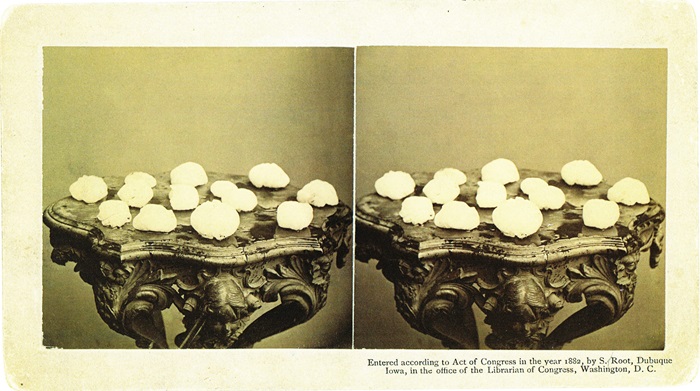As we look toward spring and summer, the weather takes a turn away from snow and cold temperatures toward gentle rains with the possibility of thunderstorms and maybe even tornadoes. Gentle rainfall was a far cry from what descended on Dubuque on Friday, June 16, 1882, when a foreman at the city’s Millwork District Novelty Iron Works claimed to have found two small, live frogs imbedded inside massive hailstones.

This may sound like a tall tale that has been passed on down through the decades, but the 1882 hail storm actually did occur in Dubuque. The June 1882 issue of the Monthly Weather Review reported that on June 16th, Dubuque was hit by “The largest and most destructive hailstones.” Although several other states across the Midwest were also the target of large hail storms, apparently Iowa and especially Dubuque received the brunt of the destruction. Within a short thirteen minutes, a terrifying storm descended on the city and delivered hailstones measuring from one to seventeen inches in circumference. The Weather Review also claimed that the biggest hailstone tipped the scales at an astounding one pound twelve ounces.
A second source from the U.S. Army Signal Corps, Dubuque’s official weather service for some twenty years up until 1890, adds credibility to the frog hail story. The local officer assignment to the Signal Corps kept a daily log and noted that a resident had discovered two live frogs imbedded in hail.
When The Daily Herald, Dubuque’s local newspaper, came out the following day, citizens weren’t surprised to read the bold headlines – “All Hail! The Most Terrific Hail Storm on Record.” The journalist writing for the paper described the timeline of the storm in detail. The storm began with thunder, lightning, and a deluge of rain that lasted from nine in the morning until around noon. Then the weather cleared up and folks breathed a sigh of relief, thinking that the storm had passed. But later in the day, the weather changed dramatically. Around three in the afternoon, thick dark clouds gathered in the northeast and moved rapidly to the south. “It was thought a tornado was about to visit destruction upon our city. But instead, small hailstones were hurled against the buildings and upon the ground…the hailstones became larger…[and] rattled against the windows and upon the roofs of the buildings with such force that they pierced almost everything they touched, and the noise of the frozen missiles put old veterans in the mind of the rattling of musketry.”
To read the remainder of this article and other premium articles in their entirety, pick up the April 2025 issue of Julien’s Journal. Single issues are available in print at area newsstands, or you can click here to read the entire article in the digital version of the magazine.
Read Julien’s Journal from the Comfort of Your Home!
Click to subscribe for convenient delivery to your home or business by mail or call 563.557.7571.


Comment here